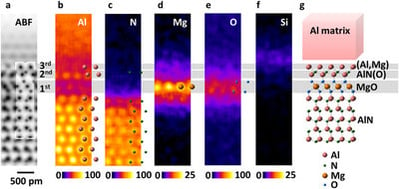PRESS RELEASE
- Research
- 2016
Atomic structures of a liquid-phase bonded metal/nitride heterointerface
Authors
Akihito Kumamoto, Naoya Shibata, Kei-ichiro Nayuki, Tetsuya Tohei, Nobuyuki Terasaki, Yoshiyuki Nagatomo, Toshiyuki Nagase, Kazuhiro Akiyama, Yoshirou Kuromitsu & Yuichi Ikuhara
Abstract
Liquid-phase bonding is a technologically important method to fabricate high-performance metal/ceramic heterostructures used for power electronic devices. However, the atomic-scale mechanisms of how these two dissimilar crystals specifically bond at the interfaces are still not well understood. Here we analyse the atomically-resolved structure of a liquid-phase bonded heterointerface between Al alloy and AlN single crystal using aberration corrected scanning transmission electron microscopy (STEM). In addition, energy-dispersive X-ray microanalysis, using dual silicon drift X-ray detectors in STEM, was performed to analyze the local chemistry of the interface. We find that a monolayer of MgO is spontaneously formed on the AlN substrate surface and that a polarity-inverted monolayer of AlN is grown on top of it. Thus, the Al alloy is bonded with the polarity-inverted AlN monolayer, creating a complex atomic-scale layered structure, facilitating the bonding between the two dissimilar crystals during liquid-phase bonding processes. Density-functional-theory calculations confirm that the bonding stability is strongly dependent on the polarity and stacking of AlN and MgO monolayers. Understanding the spontaneous formation of layered transition structures at the heterointerface will be key in fabricating very stable Al alloy/AlN heterointerface required for high reliability power electronic devices.

Abstract URL:http://www.nature.com/articles/srep22936

